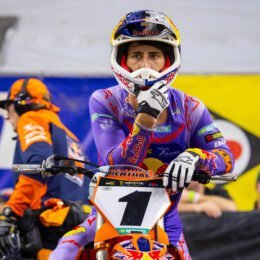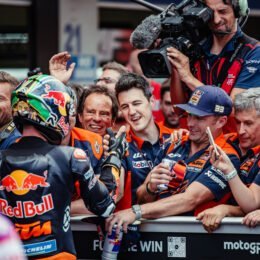The forbidden place: Lifting the lid on KTM R&D
An extremely rare peek at the birthplace of orange motorcycles was afforded to a select few press at Mattighofen last week and as we can sometimes escape corporate binds here on the BLOG this is what we found in the depths of R&D …
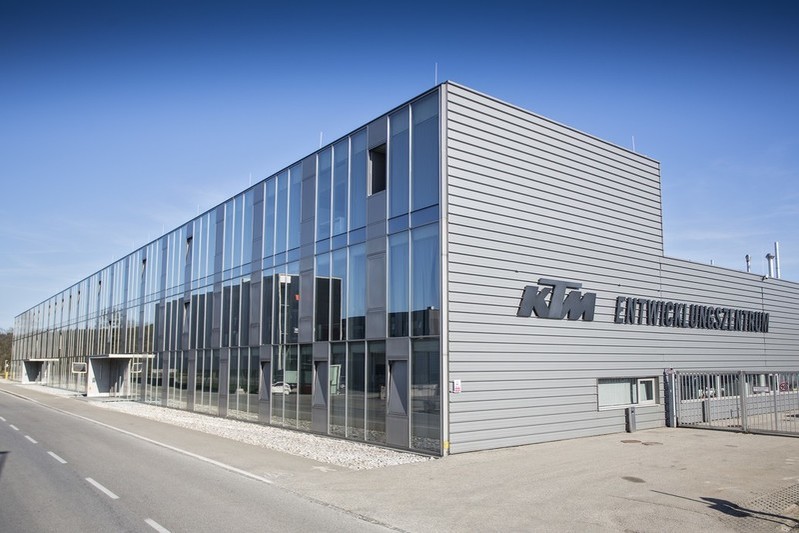
KTM R&D building Mattighofen 2016
An unusual situation this. After a comprehensive presentation on the technical and mechanical elements that constitute the base of any KTM (engine, components, electronics with Bosch, WP suspension) we were shown around the R&D department on the other side of the road to the Mattighofen assembly lines. Normally this is the part of a motorcycle factory that is strictly off-limits. Our access today is of course controlled – things are covered, no cameras allowed, we do not enter all corners of the facility and some work/details from the engineers remain private – but it is still a unique chance for some insight into the creation and process of a bike, and it is bewildering to digest all of the manpower and technical expertise that is involved.
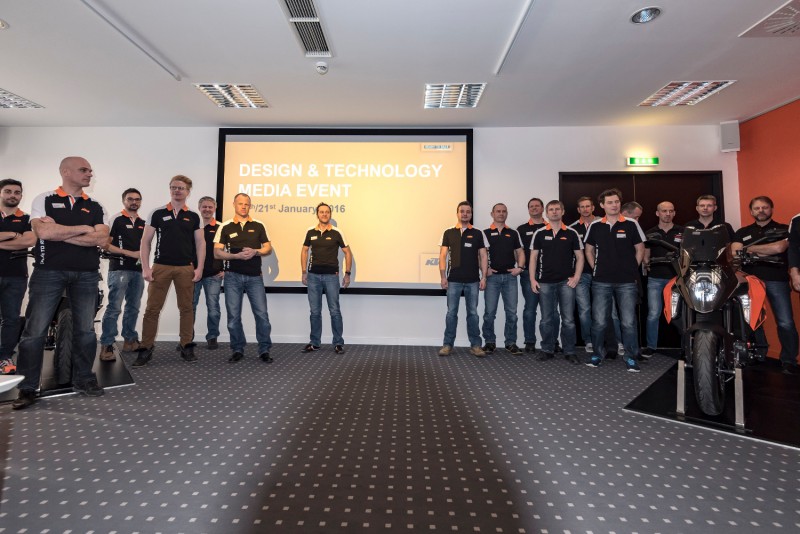
KTM Design & Technology Media Event 2016
The first aspect we have to grasp is how R&D has transformed dramatically as the company has surged ahead with expansion of its model portfolio. Toby Gustafson from WP fondly recalls his time at KTM in the 1990s when there were just twelve people in the department. Now there are almost four hundred. The building itself – what was the old race workshop – required the construction of a third floor to accommodate the knowledge and labor going into the latest street machinery and the engines and technology that is winning races and prestige on the tracks and trails.
Amusingly our PR guide to R&D doesn’t even have a swipe card access to the imposing grey door but once we are inside and sheltering from the bracing Austrian temperatures of -7 degrees we are steered directly to the data recording bay …
Data recording
A vast chamber contains an 1190 ADVENTURE saddle strapped onto a pivot plate and with the bottom half of a mannequin fixed in place and panniers also in position. Behind the glass the whole unit moves to replicate bumps and wear on the luggage carrying capabilities of the components while computer screens monitor the activity.
Test benches like this are running almost seven days a week and costs 250,000 euros to install. The simulation we are watching is functioning at a speed equivalent to a ‘ride’ for 250 hours meaning a test period seven times shorter than that on the road. The bench can measure parameters such as jumps on a Motocross track as well. “This is an example of the investment made to product development and the direct request made to the CEO for infrastructure,” offers Press and PR Guru Thomas Kuttruf. “Most of the budget comes in the back door and ends up here.”
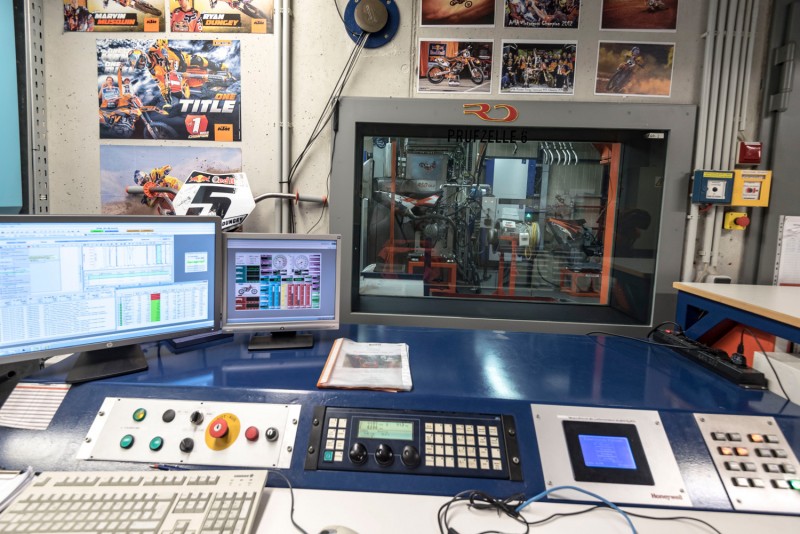
In a separate workshop a 350 SX-F model – looking a Frankenstein’s Monster of a dirt bike – has been over-loaded with sensors and cables in an operation that took more than three months for the technicians to complete. They measure acceleration, pressure and forces (for example in the wheels hubs) and then apply them to the test bench for optimization. A normal measurement period with someone riding the bike can be one week but it depends on the request.
“It is important that the rider is not limited by it all and that he can ride the bike normally. The added weight is typically not more than a couple of kilos,” we are told.
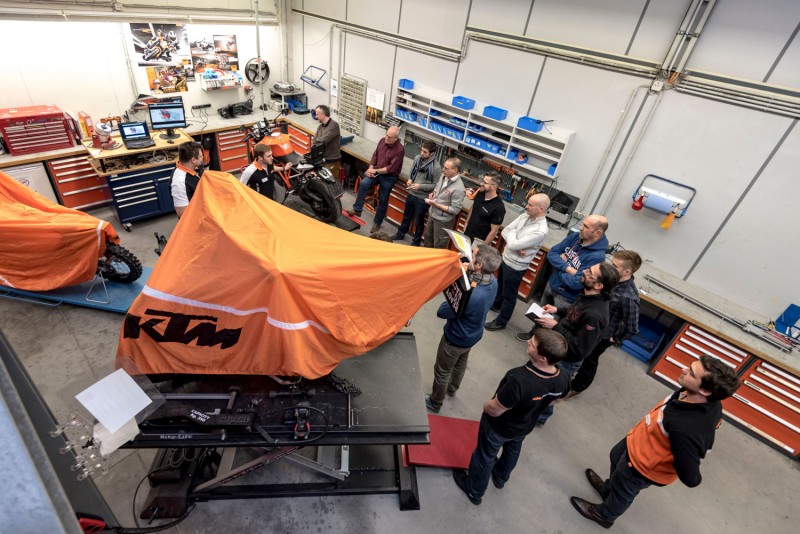
Fatigue strength
The findings of data recording are syncronized with our next step of the swift R&D tour and Head of Fatigue Strength Anton Mayr is a willing guide. The guys here focus on Load Data Acquisition and we see examples of their ‘work’ in a video of burnouts, jumps, hitting potholes, drifting, two-up wheelies and stoppies. We are shown an analysis that measures the load on front and back wheels from these activities. Another clip – this time computer generated – reveals the stresses of braking and changing gear on the aluminium footpegs and levers shown in blue and green. “Then we can see areas where we can even reduce material and get a lightweight bike,” Mayr offers. A similar scan of the rear frame shows the hotspots under 7G of force (like a jump) as well as the stresses of a top box mounting. “This is our work; to see if welding and bolts are OK and can carry the loads. The calculations of engineers is important for our success.”
So a lot of basic data is recorded with the primary purposes of resistance, durability and safety. After testing components the Fatigue Strength crew get the first prototype and then test through three stages: a) calculating the limits, b) a complete test and then c) full bike test. “The component needs to pass all three stages for a green card and serial production,” asserts Mayr.
KTM have a vast test fleet doing the dirty work on the actual roads and surfaces but there are also other means inside the workshop. The center of gravity cradle (weird to see a full bike, a GT, swinging away) is made in-house and compiles data for handling measurement and comparisons for new concepts and points for different engines and riding positions. Another contraption is putting stress on a handlebar. Results are compiled but obviously some components on the bike also depend on other parts and even partners like WP. Mayr: “This is one of the best test simulators but it’s true that a test bench cannot be the same as real riding.” There will be 2-3 dynamics tests as well as other statics all happening at the same time, so there can be 6-7 components being put through their paces on any given day.
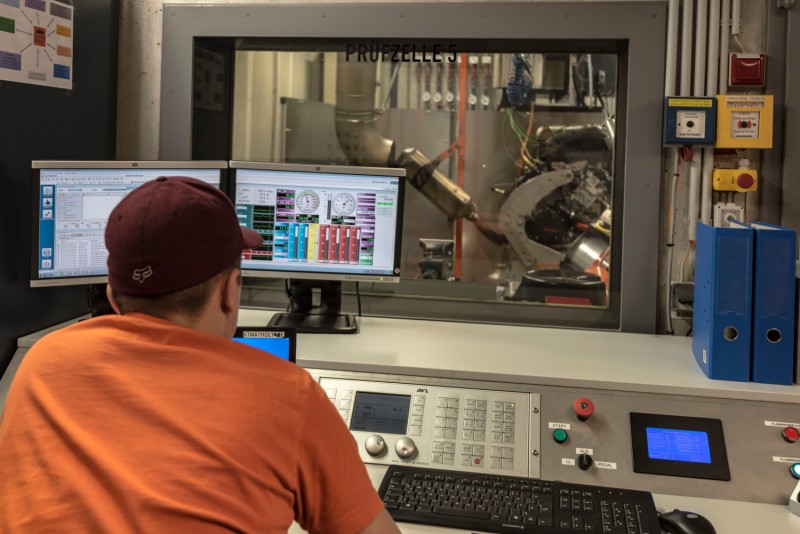
Another video plays of 1290 SUPER DUKE GT bouncing around on the two-poster bench and simulating road riding, offroad and extreme riding. Looking to our right some wheel hubs are being rattled at an impossible fast rate, simulating a customer constantly riding, braking and accelerating. It will run for thirty-forty hours and although we are not told the mileage we are informed that it is around half of a passenger car. Mayr admits that the hardest conditions “are the most use” and that feedback from the KTM Dealer network and analysis of customer use helps inform the test parameters.
Tests are normally over-scaled to get faster results and these can be difficult to set as parts do eventually break. The two-poster bench is very expensive and typically runs between two-three hundred hours. “The fork and shock get too hot if you go too fast”.
Again we are told that the principal purpose of ‘F&S’ are the readings: “any problems from customer service also come to us.” They test around forty parts of a bike with the objective of safety and the failure rate is – and has to be – 0%. Mayr: “For functional or quality parts like plastics or a shift lever we do not test at the same intensity as for safety. There is not the same hard limit.”
Test benches
Moving on we come to one of the thirteen test benches KTM have in a corridor that almost runs the length of the R&D building. The bench is another big chamber with a cannibalized bike inside, barely recognizable as another GT. We pass similar set-ups that merely house an engine. This time Katja is working on NVH (noise vibration harshness) and has the GT in place on the rolling road with ventilation and emissions ducts. The evaluation of the bike falls into two parts: comfort points (so vibration through the handlebars, footrests and mirrors) and electrical parts (“these are sensitive to vibration and using sensors we can also see where fatigue is evident like, say, the radiator”).
A sensor has three directions or channels and Katja places ten pieces of hardware on the GT giving her thirty readings across the bike. The data comes from the effect of the engine alone and obviously not from the street, bumps or jumps “that comes from another test bench” she says. “We set a test reference so if there are any changes to the engine settings then we have a comparison point. We measure across a spectrum of rpm. If we have to fix something then the project leader of the bike will talk with the supplier or the right department.”
Regulation of vibration is achieved through damping. “It is also like a ping pong effect between us, the Project Leader and the manufacturer of a particular part,” Katja says. Development can take up to a month but can sometimes be quicker depending on experience gleaned from other bikes and engines. Katja ‘rides’ the bike to achieve her readings. “I can be three days measuring this [the GT] but afterwards the analysis is even longer.”
Engines
Our last stop takes us past the door (unfortunately) marked ‘MotoGP’ and onto one of the engine benches where Hannes and Matthias are happy to outline what is happening with their current project.
The heart of a 1290 SUPER ADVENTURE – that seems cruelly detached, almost tortured – has been caged and bound on a 3500rpm cycle and the test bench can: a) control the engine dyno and all the parameters like water temperature and total power output “we can very easily limit and stop the engine”, b) Gives control of the ECU and allows settings for ignition and timing and c) Hannes says: “we can check cylinder pressure and see how combustion is looking.”
New engines are normally run-in for an hour then serviced and put through the tests. A plethora of sensors check values “from exhaust gas pressure to oil pressure and many more that are important” says Matthias. Torque is measured up to 500 newton metres. Fuel is also conditioned and kept constant at twenty degrees. Hannes: “We do many endurance tests and ECU calibration. Every ten to fifteen hours it is stopped for oil and filter changes. We work mainly with newly developed engines and that means some race ones as well. We haven’t had the MotoGP engine here … the test bench would not be able to take it.”

As we are led back into the biting daylight Hannes’ last line on the RC16 project stays with us. Having absorbed the genesis of a Mattighofen motorcycle it is hard not to imagine a vast orange blur on the MotoGP asphalt very soon. As with so many of these ‘insider’ events, the accumulative effect is the desire to grab a helmet and try the end product. A 1290 SUPER DUKE GT has never felt more appealing.
Photos: Marco Campelli | KTM

